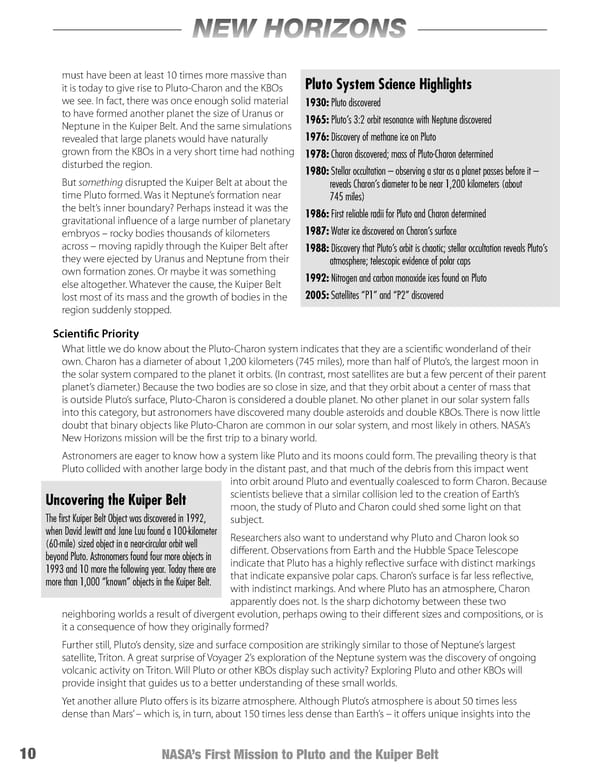NEW HORIZONS must have been at least 10 times more massive than Pluto System Science Highlights it is today to give rise to Pluto-Charon and the KBOs we see. In fact, there was once enough solid material 1930: Pluto discovered to have formed another planet the size of Uranus or 1965: Pluto’s 3:2 orbit resonance with Neptune discovered Neptune in the Kuiper Belt. And the same simulations revealed that large planets would have naturally 1976: Discovery of methane ice on Pluto grown from the KBOs in a very short time had nothing 1978: Charon discovered; mass of Pluto-Charon determined disturbed the region. 1980: Stellar occultation – observing a star as a planet passes before it – But something disrupted the Kuiper Belt at about the reveals Charon’s diameter to be near 1,200 kilometers (about time Pluto formed. Was it Neptune’s formation near 745 miles) the belt’s inner boundary? Perhaps instead it was the 1986: First reliable radii for Pluto and Charon determined gravitational influence of a large number of planetary embryos – rocky bodies thousands of kilometers 1987: Water ice discovered on Charon’s surface across – moving rapidly through the Kuiper Belt after 1988: Discovery that Pluto’s orbit is chaotic; stellar occultation reveals Pluto’s they were ejected by Uranus and Neptune from their atmosphere; telescopic evidence of polar caps own formation zones. Or maybe it was something 1992: Nitrogen and carbon monoxide ices found on Pluto else altogether. Whatever the cause, the Kuiper Belt lost most of its mass and the growth of bodies in the 2005: Satellites “P1” and “P2” discovered region suddenly stopped. Scientific Priority What little we do know about the Pluto-Charon system indicates that they are a scientific wonderland of their own. Charon has a diameter of about 1,200 kilometers (745 miles), more than half of Pluto’s, the largest moon in the solar system compared to the planet it orbits. (In contrast, most satellites are but a few percent of their parent planet’s diameter.) Because the two bodies are so close in size, and that they orbit about a center of mass that is outside Pluto’s surface, Pluto-Charon is considered a double planet. No other planet in our solar system falls into this category, but astronomers have discovered many double asteroids and double KBOs. There is now little doubt that binary objects like Pluto-Charon are common in our solar system, and most likely in others. NASA’s New Horizons mission will be the first trip to a binary world. Astronomers are eager to know how a system like Pluto and its moons could form. The prevailing theory is that Pluto collided with another large body in the distant past, and that much of the debris from this impact went into orbit around Pluto and eventually coalesced to form Charon. Because Uncovering the Kuiper Belt scientists believe that a similar collision led to the creation of Earth’s moon, the study of Pluto and Charon could shed some light on that The first Kuiper Belt Object was discovered in 1992, subject. when David Jewitt and Jane Luu found a 100-kilometer Researchers also want to understand why Pluto and Charon look so (60-mile) sized object in a near-circular orbit well different. Observations from Earth and the Hubble Space Telescope beyond Pluto. Astronomers found four more objects in indicate that Pluto has a highly reflective surface with distinct markings 1993 and 10 more the following year. Today there are that indicate expansive polar caps. Charon’s surface is far less reflective, more than 1,000 “known” objects in the Kuiper Belt. with indistinct markings. And where Pluto has an atmosphere, Charon apparently does not. Is the sharp dichotomy between these two neighboring worlds a result of divergent evolution, perhaps owing to their different sizes and compositions, or is it a consequence of how they originally formed? Further still, Pluto’s density, size and surface composition are strikingly similar to those of Neptune’s largest satellite, Triton. A great surprise of Voyager 2’s exploration of the Neptune system was the discovery of ongoing volcanic activity on Triton. Will Pluto or other KBOs display such activity? Exploring Pluto and other KBOs will provide insight that guides us to a better understanding of these small worlds. Yet another allure Pluto offers is its bizarre atmosphere. Although Pluto’s atmosphere is about 50 times less dense than Mars’ – which is, in turn, about 150 times less dense than Earth’s – it offers unique insights into the 10 NASA’s First Mission to Pluto and the Kuiper Belt
 New Horizons Page 16 Page 18
New Horizons Page 16 Page 18